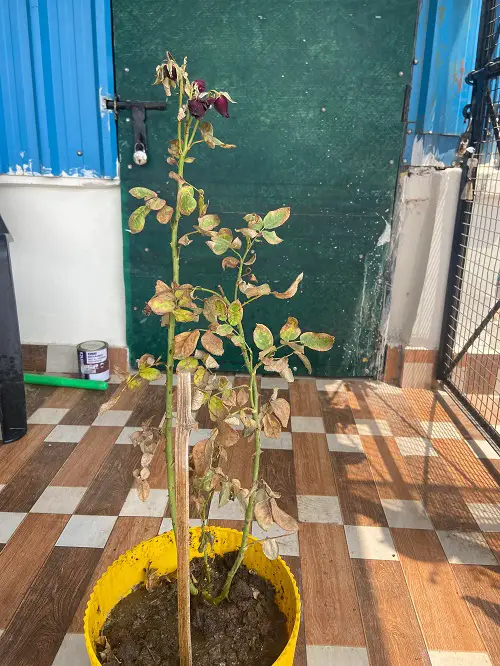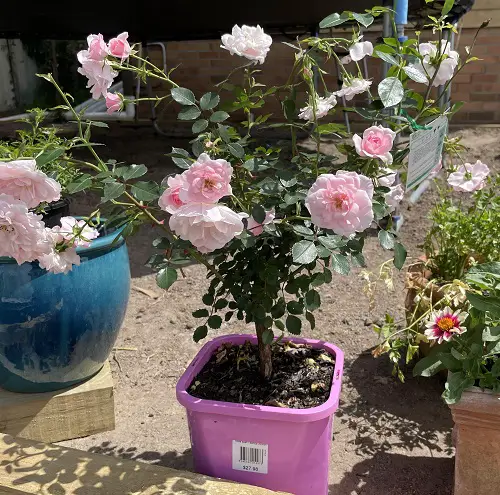Here are some of the most common Problems With Roses in Pots and Their Solutions so you can eliminate them for good!
Who doesn’t love rose pots all around their home? We all want them to be full of flowers all the time! Of course, sometimes, these plants run into issues that can hamper their health and blooming. But they won’t harm you much if you know these problems with roses in pots and their solutions!
Problems With Roses in Pots and Solutions
1. The Pot Isn’t Big Enough

When grown in the garden, roses have plenty of space to grow and expand–but in pots, the space is limited. You have to strike the right balance. A container size of 12-16 inches will be a good starting point, and it will serve the plant well for a few years.
Let it thrive in it until you see signs of roots emerging on the topsoil or from the drainage hole at the bottom. This indicates that the plant has reached the limit of the pot and that it is time to repot it in a new one.
Beyond simply repotting, pay attention to the root structure. Roses develop a taproot system, which means depth is as crucial as width. When selecting a new pot, ensure it’s wider and deeper than the previous one by a few inches. But, do not use a pot that’s more than 1-2 sizes bigger than the old one (to save it from overwatering woes). Also, use a fresh growing medium with every re-potting.
2. Rose Pot Watering Issues

Container roses require more frequent watering than garden roses. Why? Well, the limited soil volume dries out faster, especially during warmer months. Plus, these moisture fluctuations stress the plant, leading to leaf drop and bud failure.
This doesn’t mean that you should water them way more! Remember, roses hate overwatering, and a plant with too much moisture will look like the image above–brown and wilting.
So, what’s the proper method to follow? Simple! Water when the topsoil feels a little dry to touch, about 1/2 an inch deep, which can be once every 2-5 days, depending on the weather and climatic conditions. Remember, watering deeply until water drains from the bottom of the pot is more effective than frequent, shallow watering.
3. The Soil Gets Depleted

Since the growing medium is limited, roses grown in containers quickly deplete nutrients. The best way to deal with this is to add a handful of manure and compost to the pot every 4-6 weeks and till it thoroughly.
You can also use Epsom salt (dilute one tablespoon in a gallon of water) and moisten the growing medium every month. Roses benefit significantly from a slow-release fertilizer at the beginning of the growing season, providing a steady supply of nutrients, so give them that. You can also try these ones!
4. The Light Isn’t Right
When people grow roses in pots, they often keep them in a certain spot and forget about them. If you are one of those people, you need to refrain from doing this!
Roses LOVE sunlight (about 6 hours a day), but too much of it can scorch their leaves, especially if you live in a warm zone. So, what’s the catch? The best location for these beauties is an East or South facing spot.
East-facing means direct morning sun exposure, which is mild, giving the plant the right amount of light all day long. With a South-facing spot, you may have to use curtains to block the direct sunlight in the afternoon.
Pro Tip: Did you know? The color of the pot can also influence soil temperature. Dark-colored pots absorb more heat, which can be beneficial in cooler climates but detrimental in warmer ones. In hot regions, opt for light-colored pots to reflect sunlight and keep the soil cooler.
5. Diseases and Pests

Pest and disease issues are clearly visible so you can take care of them promptly. The confined space of containers can foster development of diseases like powdery mildew and pests like spider mites, especially if the air circulation is poor.
Aphids and leafhoppers also like to infest roses, and can multiply quickly, causing extensive damage. Just make sure the plant gets proper air circulation. For this, prune crisscross branches and deadhead spent flowers from time to time. You should also try neem oil!
Neem oil is a natural insecticide and fungicide that can help protect roses from all common pests and diseases. Apply it regularly, especially during periods of high humidity or pest activity. Also, encourage beneficial insects, such as ladybugs and lacewings, which prey on aphids and other pests.
6. The Soil Needs More Drainage

If the soil isn’t right, it isn’t right! That’s why it is extremely important to use a potting mix that drains well for roses. Here’s what to gather.
- Three parts garden soil
- Two parts compost
- One part coarse sand
- One part perlite
- Half part bone meal
Mix all of these well, and you will definitely have the best flowers and a healthy plant! The thing is, the size of the particles in your potting mix also affects drainage. Coarse materials like perlite and sand create larger air spaces, allowing water to drain more freely.
Avoid using fine-textured materials, such as clay-heavy garden soil, which can retain too much moisture. Simple, right?
7. Your Roses Need Support
Another problem with roses in pots that people often overlook is giving them the right kind of support. While growing climbing varieties in pots, you need to give them this from an early stage using stakes, trellis, or bamboo poles to ensure the stems don’t droop and touch the ground. Otherwise, they will catch diseases. Here are some great DIYs for this!
A sturdy trellis or arbor is excellent for vigorous climbers. For smaller varieties, stakes or a simple wire support may suffice. Just make sure the support structure is securely anchored to prevent it from tipping over, especially in windy conditions. Also, use soft ties, such as cloth strips or garden twine to secure the rose stems to the trellis.
Well, what are you waiting for? If you have seen one of these problems with roses in pots, rush over and immediately give it what it needs! Do share your experience in the comments below!


